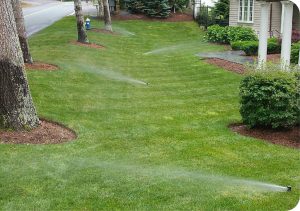Irrigation carries water from its source to plant roots via a network of pipes, valves, and sprinkler heads. Using sustainable irrigation practices promotes healthy landscapes and supports long-term ecological goals.

Irrigated agriculture uses 70 percent of global water withdrawals and supplies 40 percent of the world’s food. It can offer crop yields two to four times greater than rainfed farming. Visit https://vantaoutdoors.com/irrigation/ to learn more.
Irrigation is a valuable resource for keeping landscapes healthy and productive. It helps farmers achieve bountiful harvests, supports different soil types, and even preserves the water table in aquifers. But irrigation can also be inefficient if it fails to supply the right amount of water at the right time. The key to efficient irrigation is knowing your plants and how to best manage them.
Plants respond to water stress in different ways, and these responses help you identify their needs. For example, alfalfa and other legumes exhibit visible signs of drought when they turn dark green or wilt. Some annual species may show color changes as well. In addition, the amount of water needed by each species depends on atmospheric and soil conditions. For instance, evaporation from the surface of the soil, soil permeability, and nutrient availability all affect how often and how deeply a crop will absorb water.
The frequency and depth of irrigation must match the water-absorbing capacity of the soil, the stomata (leaves) and roots, and the water retention capability of the forage crop. In addition, water must be delivered to the correct place in the plant and not lost from evaporation or deep percolation. This is an important consideration in the design of irrigation systems, and it can be minimized by maximizing the use of soil permeability, ridges, and plant spacing to ensure that all desired plants receive the water they need.
Another critical factor is determining how to deliver the water, whether using surface or subsurface irrigation methods. Surface irrigation uses pipes or hoses to distribute water over the ground. It is relatively inefficient because some water is lost to weeds and surface evaporation, and other plants may not receive enough water due to their location relative to the spray nozzle.
Underground drip irrigation uses a network of controllers, valves, pipes, and heads to water the landscape. It can be very efficient because it delivers the exact amount of water needed to the root zone at each plant, and allows you to avoid surface evaporation. However, it requires careful planning and installation to ensure that the system meets your landscape needs.
Water
Using water efficiently is essential for sustainable landscaping. Irrigation is the process of channeling water from a source (pond, well, water tank, municipal water supply) to plants across your landscape, through pipes, valves, and sprinklers or drip lines. The system can be designed to meet specific water needs, maximizing conservation and efficiency.
A successful irrigation design is one that maximizes soil moisture and nutrient utilization while minimizing salt imbalances, leaf burn, surface erosion, and water loss. Water losses are due to evaporation from the soil surface, runoff and drift, and deep percolation of water below the root zone. Soil type, texture and depth, plant spacing, ridges, and timing of irrigation affect how much water the soil can retain and how efficiently it is used by the plant.
Different crops have varying water requirements with regard to both quantity and time of application. Water needs must be balanced against cost of irrigation, the potential increase in crop yield and quality, and the amount of rainfall available.
Water is a precious resource and it is important to use it wisely. Irrigation helps to conserve water by reducing the number of irrigation cycles required to reach desired soil moisture levels. It also provides water when needed most by reducing the evaporation rate in the soil. It is best to irrigate in the early morning to reduce runoff and to allow plants to use the water before the sun rises.
Irrigation is a significant contributor to global agricultural production. It offers crop yields up to two to four times greater than is possible with rainfed farming, enabling a high standard of living for many people worldwide. However, the expansion of irrigation has been slowing in recent years due to unsatisfactory performance of formal large canal systems and recognition of environmental impacts.
Sustainable irrigation practices reduce the amount of water needed for a healthy, self-sustaining landscape. This is achieved by evaluating the local soil and microclimate, implementing the right irrigation techniques to achieve your landscape goals, and utilizing smart controllers to provide optimal usage. Examples of sustainable irrigation strategies include adjusting water levels based on soil moisture, using circular patterns to avoid over-watering certain areas, and limiting turf areas that require supplemental irrigation.
Maintenance
Regular inspections of pipes, valves, and sprinkler heads detect and repair any issues that could cause inefficient watering or plant damage. System settings are adjusted to reflect seasonal changes, weather conditions, and plant needs. For example, plants need extra water in the summer due to higher temperatures and evaporation rates, while winter irrigation is limited or stopped to prevent freeze damage to both the infrastructure and the roots. Watering to the specific requirements of individual vegetation reduces overall water use and conserves precious resources. Irrigation systems also provide benefits such as increased agricultural productivity, improved landscape aesthetics, and the preservation of natural resources. They contribute to regional food security and economic vitality in regions with varying water availability.
Proper maintenance of irrigation systems ensures long-term performance and sustainability.